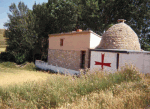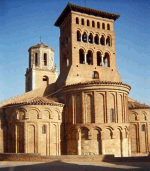written and photographed by Guy Dalcourt
Oct 2003, Vol. 8 No. 1
 As the years fade into my six decade, I made a long and thoughtful decision to challenge Spain’s 500 kilometer (315-mile) hiking pilgrimage from Burgos to Santiago de Compostela, Spain, better known as the Camino Frances or to most folks, just “El Camino”. Setting aside my desk job to fulfill this yearning, I began training in earnest for this grueling trip.
As the years fade into my six decade, I made a long and thoughtful decision to challenge Spain’s 500 kilometer (315-mile) hiking pilgrimage from Burgos to Santiago de Compostela, Spain, better known as the Camino Frances or to most folks, just “El Camino”. Setting aside my desk job to fulfill this yearning, I began training in earnest for this grueling trip.
A heart attack in ’81 had necessitated some life style changes; adding an exercise program and changing some eating habits to include a primarily vegetarian diet. Now I look back to the day when I could barely walk a single block. Rehab supported me through a ten-kilometer walk, but I was on my own after that. I tackled my first marathon on my own. What pride I feel having recovered from a life-threatening encounter to the achievement of 22 days of hiking “El Camino” in Spain.
 My commitment to tackle “El Camino” was achieved during the summer of 2003. Life became focused on training, training, and more training! Four months prior to departure, my exercise shifted to spend time in the gym doing strength training. Weekends were committed to walking distances up to 25 km (more than 12 miles) while carrying 25 pounds in my pack.
My commitment to tackle “El Camino” was achieved during the summer of 2003. Life became focused on training, training, and more training! Four months prior to departure, my exercise shifted to spend time in the gym doing strength training. Weekends were committed to walking distances up to 25 km (more than 12 miles) while carrying 25 pounds in my pack.
On July I, I stuffed the back pack to board a plane to Spain. I wouldn’t recommend making this pilgrimage during the summer months. While I did encounter rain, sleet, and wind at the pass of Cruz de Ferro (Iron Cross), most days were spent hiking in temperatures hovering around 40 degrees Celsius (110 degrees Fahrenheit). A better plan would have been to make the pilgrimage during spring or fall.
 The trek began in Burgos, Spain and ended a distant 500 kilometers in Santiago de Compostela. The trail passed through ancient villages featuring Romanesque churches, and verdant countryside vineyards. It was a landscape too beautiful to describe. Locals passing along the route beckoned a cheerful Buenos Dias or Bon Camino.
The trek began in Burgos, Spain and ended a distant 500 kilometers in Santiago de Compostela. The trail passed through ancient villages featuring Romanesque churches, and verdant countryside vineyards. It was a landscape too beautiful to describe. Locals passing along the route beckoned a cheerful Buenos Dias or Bon Camino.
In the village of Rabanal del Camino about 60 pilgrims participated with Benedictine monks as they performed Vespers in the old Gregorian tradition. The church was full as we did these readings in French, German, English, and Spanish.
During the ninth century, St. James the Apostle’s tomb was discovered a Roman-era tomb in Northern Spain. During the following several centuries the number of pilgrims visiting the tomb increased dramatically. As a result, a great cathedral was constructed in Santiago followed by the building of a city.
 Devotees weaved paths from France and as far away as Scandinavia to pay homage to the shrine. There is a premise that European pilgrimages to Santiago were preceded by the arrival of the Romans on the Iberian Peninsula. Archeological evidence indicates that Celtic tribes also made their way to Northern Spain by following the stars of the “Milky Way” to guide them toward Finisterra along the coast, deemed to be the finis (end) terra (earth) or “end of the earth”.
Devotees weaved paths from France and as far away as Scandinavia to pay homage to the shrine. There is a premise that European pilgrimages to Santiago were preceded by the arrival of the Romans on the Iberian Peninsula. Archeological evidence indicates that Celtic tribes also made their way to Northern Spain by following the stars of the “Milky Way” to guide them toward Finisterra along the coast, deemed to be the finis (end) terra (earth) or “end of the earth”.
 While the pilgrimage tradition is still very much alive, modern transportation has resulted in fewer people making the arduous trek. The numbers have escalated since Unesco declared the Camino de Santiago a European Cultural Route in the 1980’s and then a Cultural Heritage Route in 1993. In recent years as many as 60,000 hikers, cyclists, and horseback riders have made this pilgrimage.
While the pilgrimage tradition is still very much alive, modern transportation has resulted in fewer people making the arduous trek. The numbers have escalated since Unesco declared the Camino de Santiago a European Cultural Route in the 1980’s and then a Cultural Heritage Route in 1993. In recent years as many as 60,000 hikers, cyclists, and horseback riders have made this pilgrimage.
 My journey, which averaged 25 kilometers a day, took 22 days to complete. In order to avoid the heat of the day, I awoke early and hit the trail as soon as possible. Like myself, other find peace in making this pilgrimage alone. Along the way, I met wonderful people from all walks of life from all over the world.
My journey, which averaged 25 kilometers a day, took 22 days to complete. In order to avoid the heat of the day, I awoke early and hit the trail as soon as possible. Like myself, other find peace in making this pilgrimage alone. Along the way, I met wonderful people from all walks of life from all over the world.
 By late afternoon, after wandering the rolling hills of wheat and hay, admiring stork’s nests in almost every church steeple, I began thinking about a good night’s rest. Search the guidebook I carried for an “alberque”, a “credencial” or pilgrim’s passport was required to overnight at these places. Albergues, while not luxurious, offer a clean dormitory-style bed and provide a solid and substantial meal served up with local wine. The cost is less than $10 dollars for the night. There are also small well kept hotels along the way. Villages and towns along the route offered different amenities, but food, water and “café con leche” were always available.
By late afternoon, after wandering the rolling hills of wheat and hay, admiring stork’s nests in almost every church steeple, I began thinking about a good night’s rest. Search the guidebook I carried for an “alberque”, a “credencial” or pilgrim’s passport was required to overnight at these places. Albergues, while not luxurious, offer a clean dormitory-style bed and provide a solid and substantial meal served up with local wine. The cost is less than $10 dollars for the night. There are also small well kept hotels along the way. Villages and towns along the route offered different amenities, but food, water and “café con leche” were always available.
Three weeks of solitude gave me time to think and reflect on my life. Not only was this pilgrimage a great physical challenge, it was an accomplishment and achievement of which I will always be proud.
Tips for getting ready for the trip:
- Feet First! The primary reason people fail to complete their trek is because their feet fail them. Get expert advice for wearing the best hiking shoe for your foot, and take a blister kit with you. Even the best of footwear doesn’t always protect you from an occasional blister.
- Research your trip! Get a good guide. Check out “El Camino” on the internet. Map your route and follow it.
- Next to the wonderful people I met on my pilgrimage, my very best friend were a pair of “poles”. I used spring-loaded walking poles. They will become your best friend, too, when walking up and down countless hills along the way. Poles can also help ease back strain. Held horizontal to the ground under your backpack, they give the back a rest.
- Remember that these uneven footpaths were used during ancient times and “El Camino” was created by the footsteps of many pilgrims following the same topography for centuries. Unlike a road that cuts through the terrain, the path follows all the hills and valleys.
- Another crucial piece of equipment is your back pack. Experts will tell you to not to exceed carrying a maximum weight of 10 to 12 kilos or 22 to 25 pounds. Spend training time balancing the items in your pack for greater comfort.
- Your trip will be enhanced by learning to speak some Spanish. Very few locals in ancient villages along the trail speak English. The better you can communicate, the more you will enjoy your trip.
For further information: guy@psea.bc.ca
